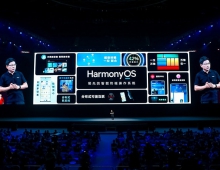
Huawei Looks To New Grounds Of Growth
After struggling in 2011, China giant Huawei bets its future on the enterprise business.
The year 2011 was tough for all telecommunication equipment and service suppliers in China due to reduced investments by major telecom carriers around the world.
BR> China's leading telecom gear maker Huawei Technologies Co. Ltd.posted its first annual decline in profit since 2007, despite meeting its 2011 operating objectives. As a result, the company is focusing on the enterprise business in order to meet its goal of becoming a $100 billion company by 2020, according to IHS iSuppli China Research from information and analytics provider IHS.
BR> Huawei in 2011 achieved a 17.2 percent annual increase in revenue to $31.6 billion, with net profit of $1.8 billion. The company predicted early in 2011 that it would reach $30.9 billion in sales, or $40 billion in orders.
BR> Because of these massive sales totals, Huawei has the capability and the endurance to commit significant resources to an objective - and that's exactly what it is doing in the enterprise business. The only remaining questions are how long Huawei will take to consolidate its foothold in global enterprise market and when the enterprise business will begin to generate cash.
BR> In 2011 Huawei's gross margin sharply declined to 37.5 percent, down from 44.0 percent in 2010. Although the company suggested that the 6.5 percentage point drop was largely attributable to foreign exchange losses due to the constant appreciation of China's renminbi currency, IHS iSuppli believes that it was also the result of Huawei's transition into the enterprise business and smartphone market. The company had strategically surrendered part of its profit to quickly seize market share in the enterprise and consumer markets.
BR> Huawei grew at a compound annual growth rate of 26.5 percent from 2007 to 2011. Furthermore, Huawei's revenue climbed nearly $20 billion during the last five years. But while Huawei's strong growth is far ahead of all its foreign rivals, the company had reached a growth ceiling in 2011. Its growth momentum was exceeded by its Shenzhen-based rival ZTE, and the revenue gap behind leader Ericsson was widening again during this year.
BR> Still, Huawei forecast a 15 to 20 percent revenue increase in 2012. The carrier network business will continue to be its primary cash cow and the engine that drives the company, even though Huawei has boldly pushed into both the consumer and enterprise business segments.
BR> To fulfill its lower limit of 15 percent revenue growth in 2012 as well as a 50 percent increase in both the enterprise and consumer areas, the company's carrier networks segment will just need to expand by a slight 2.3 percent year-on-year rate. Moreover, if the growth in enterprise and consumer businesses can exceed expectations, the company could hit the growth target even if its carrier networks business declines. In this respect, the most important role for the carrier network business is to act as a stable funding pool, not as growth generator.
BR> It's also no surprise that Huawei has announced its aim to focus on profitable growth and to conduct business with positive margins, top-line revenue growth and rising market share.
BR> Huawei's push into enterprise is also a result of increased pressure from its rivals. For instance, Ericsson pushed hard on price and sacrificed profitability in Europe in order to regain market share from Huawei in the first half of 2012. Meanwhile, ZTE continues its worldwide market attack via a low-price strategy. Furthermore, Alcatel-Lucent has the capability to counterattack in some of China's domestic markets, such as in China?s wireless passive optical network (PON) tenders.
BR> China's leading telecom gear maker Huawei Technologies Co. Ltd.posted its first annual decline in profit since 2007, despite meeting its 2011 operating objectives. As a result, the company is focusing on the enterprise business in order to meet its goal of becoming a $100 billion company by 2020, according to IHS iSuppli China Research from information and analytics provider IHS.
BR> Huawei in 2011 achieved a 17.2 percent annual increase in revenue to $31.6 billion, with net profit of $1.8 billion. The company predicted early in 2011 that it would reach $30.9 billion in sales, or $40 billion in orders.
BR> Because of these massive sales totals, Huawei has the capability and the endurance to commit significant resources to an objective - and that's exactly what it is doing in the enterprise business. The only remaining questions are how long Huawei will take to consolidate its foothold in global enterprise market and when the enterprise business will begin to generate cash.
BR> In 2011 Huawei's gross margin sharply declined to 37.5 percent, down from 44.0 percent in 2010. Although the company suggested that the 6.5 percentage point drop was largely attributable to foreign exchange losses due to the constant appreciation of China's renminbi currency, IHS iSuppli believes that it was also the result of Huawei's transition into the enterprise business and smartphone market. The company had strategically surrendered part of its profit to quickly seize market share in the enterprise and consumer markets.
BR> Huawei grew at a compound annual growth rate of 26.5 percent from 2007 to 2011. Furthermore, Huawei's revenue climbed nearly $20 billion during the last five years. But while Huawei's strong growth is far ahead of all its foreign rivals, the company had reached a growth ceiling in 2011. Its growth momentum was exceeded by its Shenzhen-based rival ZTE, and the revenue gap behind leader Ericsson was widening again during this year.
BR> Still, Huawei forecast a 15 to 20 percent revenue increase in 2012. The carrier network business will continue to be its primary cash cow and the engine that drives the company, even though Huawei has boldly pushed into both the consumer and enterprise business segments.
BR> To fulfill its lower limit of 15 percent revenue growth in 2012 as well as a 50 percent increase in both the enterprise and consumer areas, the company's carrier networks segment will just need to expand by a slight 2.3 percent year-on-year rate. Moreover, if the growth in enterprise and consumer businesses can exceed expectations, the company could hit the growth target even if its carrier networks business declines. In this respect, the most important role for the carrier network business is to act as a stable funding pool, not as growth generator.
BR> It's also no surprise that Huawei has announced its aim to focus on profitable growth and to conduct business with positive margins, top-line revenue growth and rising market share.
BR> Huawei's push into enterprise is also a result of increased pressure from its rivals. For instance, Ericsson pushed hard on price and sacrificed profitability in Europe in order to regain market share from Huawei in the first half of 2012. Meanwhile, ZTE continues its worldwide market attack via a low-price strategy. Furthermore, Alcatel-Lucent has the capability to counterattack in some of China's domestic markets, such as in China?s wireless passive optical network (PON) tenders.





















